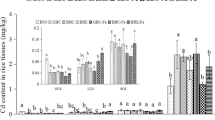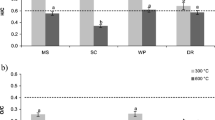Abstract
The immobilization of soil cadmium (Cd) by biochar and modified biochar is an eco-friendly and cost-effective strategy. In the current study, the effect of raw biochar (BC) and iron-modified biochar (Fe-BC) derived from common reed on the fractionation and mobility of Cd was evaluated, as was its effect on soil microbial activity in contaminated calcareous soil. Treatments involved a combination of two factors: type of biochar (CK: Control, BC, and Fe-BC) and soil Cd concentration (0, 15, and 30 mg kg−1). Treatments were applied to the soil and incubated for 90 days. The application of both biochars increased soil pH and soil organic carbon content (16.6–48.0%), microbial biomass carbon (40.5–75.1%), basal respiration (16.6–48.0%), substrate-induced respiration (12.4–41.9), and dehydrogenase activity (25.5–102.1%), while it reduced diethylene-triamine pentaacetic acid (DTPA)-extractable Cd (22.1–39.5%). The addition biochars, particularly Fe-BC, prominently decreased the concentration of exchangeable and carbonate fractions and increased the concentration of Fe-MnOx, as well as the organic and residual fractions of Cd in the soil. Moreover, relative to the control treatment, the incorporation of raw and Fe-modified biochar into 30 mg kg−1 Cd-spiked soil significantly decreased the Cd mobility factor (MF) value by 14.5 and 21.8%, respectively. Fe-modified biochar had a more significant impact than raw biochar on the immobilization of Cd in the soil, and its improved soil microbial activity to a greater extent. Overall, the findings indicate that Fe-modified biochar derived from common reed can immobilize Cd and improve soil microbial attributes in contaminated calcareous soil. Therefore, it can be used as an eco-friendly amendment for restoring Cd-contaminated calcareous soil.






Similar content being viewed by others
References
Ahmad M, Rajapaksha AU, Lim JE, Zhang M, Bolan N, Mohan D, Vithanage M, Lee SS, Ok YS (2014) Biochar as a sorbent for contaminant management in soil and water: a review. Chemosphere 99:19–33. https://doi.org/10.1016/j.chemosphere.2013.10.071
Ahmad M, Lee SS, Lee SE, Al-Wabel MI, Tsang DC, Ok YS (2017) Biochar-induced changes in soil properties affected immobilization/mobilization of metals/metalloids in contaminated soils. J Soils Sediments 17(3):717–730. https://doi.org/10.1007/s11368-015-1339-4
Alef K, Nannipieri P (1995) Methods in applied soil microbiology and biochemistry. Academic Press
Ali A, Shaheen SM, Guo D, Li Y, Xiao R, Wahid F, Azeem M, Sohail K, Zhang T, Rinklebe J, Li R (2020) Apricot shell-and apple tree-derived biochar affect the fractionation and bioavailability of Zn and Cd as well as the microbial activity in smelter contaminated soil. Environ Pollut 10:114773. https://doi.org/10.1016/j.envpol.2020.114773
Boostani HR, Hardie A, Najafi-Ghiri M, Khalili D (2018) Investigation of cadmium immobilization in a contaminated calcareous soil as influenced by biochars and natural zeolite application. Int J Environ Sci Technol 15:2433–2446. https://doi.org/10.1007/s13762-017-1544-3
Boostani HR, Najafi-Ghiri M, Hardie AG, Khalili D (2019) Comparison of Pb stabilization in a contaminated calcareous soil by application of vermicompost and sheep manure and their biochars produced at two temperatures. J Appl Geochem 102:121–128. https://doi.org/10.1016/j.apgeochem.2019.01.013
Carter MR, Gregorich EG (2008) Soil sampling and methods of analysis. Canadian Society of Soil Science, CRC Press, Taylor and Francis Group, Boca Raton
Chen D, Wang X, Wang X, Feng K, Su J, Dong J (2020) The mechanism of cadmium sorption by sulphur-modified wheat straw biochar and its application cadmium-contaminated soil. Sci Total Environ 714:136550. https://doi.org/10.1016/j.scitotenv.2020.136550
Fajardo C, Costa G, Nande M, Botías P, García-Cantalejo J, Martín M (2019) Pb, Cd, and Zn soil contamination: monitoring functional and structural impacts on the microbiome. Appl Soil Ecol 135:56–64. https://doi.org/10.1016/j.apsoil.2018.10.022
Feng Z, Chen N, Feng C, Gao Y (2018) Mechanisms of Cr (VI) removal by FeCl3-modified lotus stem-based biochar (FeCl3@LS-BC) using mass-balance and functional group expressions. Colloids Surf A Physicochem Eng Asp 551:17–24. https://doi.org/10.1016/j.colsurfa.2018.04.054
Feng Y, Liu P, Wang Y, Liu W, Liu Y, Finfrock YZ (2020) Mechanistic investigation of mercury removal by unmodified and Fe-modified biochars based on synchrotron-based methods. Sci Total Environ 719:137435. https://doi.org/10.1016/j.scitotenv.2020.137435
Hamzenejad Taghlidabad R, Sepehr E (2018) Heavy metals immobilization in contaminated soil by grape-pruning-residue biochar. Arch Agron Soil Sci 64(8):1041–1052. https://doi.org/10.1080/03650340.2017.1407872
Herrmann L, Lesueur D, Robin A, Robain H, Wiriyakitnateekul W, Bräu L (2019) Impact of biochar application dose on soil microbial communities associated with rubber trees in North East Thailand. Sci Total Environ 689:970–979. https://doi.org/10.1016/j.scitotenv.2019.06.441
IBI (2015) Standardized product definition and product testing guidelines for biochar that is used in soil. International Biochar Initiative
Jenkinson DS, Ladd JN (1981) Microbial biomass in soil. Measurement and turnover. In: Paul EA (ed) Soil biochemistry. Marcel Dekker, New York, pp 415–471
Kabala C, Singh BR (2001) Fractionation and mobility of copper, leadand zinc in soil profiles in vicinity of a copper smelter. J Environ Qual 30:485–492. https://doi.org/10.2134/jeq2001.302485x
Kabiri P, Motaghian H, Hosseinpur A (2019) Effects of walnut leaves biochars on lead and zinc fractionation and phytotoxicity in a naturally calcareous highly contaminated soil. Water Air Soil Pollut 230(11):263. https://doi.org/10.1007/s11270-019-4316-5
Kamran M, Malik Z, Parveen A, Zong Y, Abbasi GH, Rafiq MT, Shaaban M, Mustafa A, Bashir S, Rafay M, Mehmood S (2019) Biochar alleviates Cd phytotoxicity by minimizing bioavailability and oxidative stress in pak choi (Brassica chinensis L.) cultivated in Cd-polluted soil. J Environ Manag 250:109500. https://doi.org/10.1016/j.jenvman.2019.109500
Karimi A, Khodaverdiloo H, Rasouli Sadaghiani MH (2017a) Characterisation of grawth and biochemical response of Onopordum acanthium L. under lead stress as affected by microbial inoculation. Chem Ecol 33(10):963–976. https://doi.org/10.1080/02757540.2017.1391798
Karimi A, Khodaverdiloo H, Rasouli Sadaghiani MH (2017b) Fungi and bacteria as helping agents for remediation of a Pb - contaminated soil by Onopordum acanthium. Casp J Environ Sci 15(3):249–262. https://doi.org/10.22124/CJES.2017.2466
Karimi A, Khodaverdiloo H, Rasouli-Sadaghiani MH (2018) Microbial-enhanced phytoremediation of Lead contaminated calcareous soil by Centaurea cyanus L. Clean (Weinh) 46(2):1700665. https://doi.org/10.1002/clen.201700665
Karimi A, Moezzi A, Chorom M, Enayatizamir N (2019) Chemical fractions and availability of Zn in a calcareous soil in response to biochar amendments. J Soil Sci Plant Nutr 19(4):851–864. https://doi.org/10.1007/s42729-019-00084-1
Karimi A, Moezzi A, Chorom M, Enayatizamir N (2020) Application of biochar changed the status of nutrients and biological activity in a calcareous soil. J Soil Sci Plant Nutr 20(2):450–459. https://doi.org/10.1007/s42729-019-00129-5
Kaurin A, Cernilogar Z, Lestan D (2018) Revitalisation of metal-contaminated, EDTA washed soil by addition of unpolluted soil, compost and biochar: effects on soil enzyme activity, microbial community composition and abundance. Chemosphere 193:726–736. https://doi.org/10.1016/j.chemosphere.2017.11.082
Khajavi-Shojaei S, Moezzi A, Norouzi Masir M, Taghavi M (2020) Characteristics of conocarpus wastes and common reed biochars as a predictor of potential environmental and agronomic applications. Energy Source A:1–18. https://doi.org/10.1080/15567036.2020.1783396
Khodaverdiloo H, Han FX, Hamzenejad Taghlidabad R, Karimi A, Moradi N, Joseph Kazery JA (2020) Potentially toxic element contamination of arid and semi-arid soils and its phytoremediation. Arid Land Res Manag 34:361–391. https://doi.org/10.1080/15324982.2020.1746707
Lahori AH, Zhanyu GUO, Zhang Z, Ronghua LI, Mahar A, Awasthi MK, Feng SHEN, Sial TA, Kumbhar F, Ping WANG, Jiang S (2017) Use of biochar as an amendment for remediation of heavy metal-contaminated soils: prospects and challenges. Pedosphere 27(6):991–1014. https://doi.org/10.1016/S1002-0160(17)60490-9
Li B, Yang L, Wang CQ, Zhang QP, Liu QC, Li YD, Xiao R (2017) Adsorption of cd (II) from aqueous solutions by rape straw biochar derived from different modification processes. Chemosphere 175:332–340. https://doi.org/10.1016/j.chemosphere.2017.02.061
Lyu H, Tang J, Cui M, Gao B, Shen B (2020) Biochar/iron (BC/Fe) composites for soil and groundwater remediation: synthesis, applications, and mechanisms. Chemosphere 246:125609. https://doi.org/10.1016/j.chemosphere.2019.125609
Palansooriya KN, Shaheen SM, Chen SS, Tsang DC, Hashimoto Y, Hou D, Bolan NS, Rinklebe J (2020) Soil amendments for immobilization of potentially toxic elements in contaminated soils: a critical review. Environ Int 134:105046. https://doi.org/10.1016/j.envint.2019.105046
Pan D, Liu C, Yu H, Li F (2019) A paddy field study of arsenic and cadmium pollution control by using iron-modified biochar and silica sol together. Environ Sci Pollut Res 26(24):24979–24987. https://doi.org/10.1007/s11356-019-05381-x
Pan X, Zhang S, Zhong Q, Gong G, Wang G, Guo X, Xu X (2020) Effects of soil chemical properties and fractions of Pb, Cd, and Zn on bacterial and fungal communities. Sci Total Environ 715:136904. https://doi.org/10.1016/j.scitotenv.2020.136904
Qiao JT, Liu TX, Wang XQ, Li FB, Lv YH, Cui JH, Zeng XD, Yuan YZ, Liu CP (2018) Simultaneous alleviation of cadmium and arsenic accumulation in rice by applying zero-valent iron and biochar to contaminated paddy soils. Chemosphere 195:260–271. https://doi.org/10.1016/j.chemosphere.2017.12.081
Qiao J, Yu H, Wang X, Li F, Wang Q, Yuan Y, Liu C (2019) The applicability of biochar and zero-valent iron for the mitigation of arsenic and cadmium contamination in an alkaline paddy soil. Biochar 1(2):203–212. https://doi.org/10.1007/s42773-019-00015-4
Rajendran M, Shi L, Wu C, Li W, An W, Liu Z, Xue S (2019) Effect of sulfur and sulfur-iron modified biochar on cadmium availability and transfer in the soil–rice system. Chemosphere 222:314–322. https://doi.org/10.1016/j.chemosphere.2019.01.149
Saffari N, Hajabbasi MA, Shirani H, Mosaddeghi MR, Mamedov AI (2020) Biochar type and pyrolysis temperature effects on soil quality indicators and structural stability. J Environ Manag 261:110190. https://doi.org/10.1016/j.jenvman.2020.110190
Singh B, Camps-Arbestain M, Lehmann J (2017) Biochar: a guide toanalytical methods. Caliton: CSIRO Publishing, Boca Raton
Tan Z, Yuan S, Hong M, Zhang L, Huang Q (2020) Mechanism of negative surface charge formation on biochar and its effect on the fixation of soil Cd. J Hazard Mater 384:121370. https://doi.org/10.1016/j.jhazmat.2019.121370
Tang J, Zhang J, Ren L, Zhou Y, Gao J, Luo L, Yang Y, Peng Q, Huang H, Chen A (2019) Diagnosis of soil contamination using microbiological indices: a review on heavy metal pollution. J Environ Manag 242:121–130. https://doi.org/10.1016/j.jenvman.2019.04.061
Tang X, Shen H, Chen M, Yang X, Yang D, Wang F, Chen Z, Liu X, Wang H, Xu J (2020a) Achieving the safe use of Cd- and As-contaminated agricultural land with an Fe-based biochar: a field study. Sci Total Environ 706:135898. https://doi.org/10.1016/j.scitotenv.2019.135898
Tang J, Zhang L, Zhang J, Ren L, Zhou Y, Zheng Y, Luo L, Yang Y, Huang H, Chen A (2020b) Physicochemical features, metal availability and enzyme activity in heavy metal-polluted soil remediated by biochar and compost. Sci Total Environ 701:134751. https://doi.org/10.1016/j.scitotenv.2019.134751
Tessier A, Campbell PG, Bisson M (1979) Sequential extraction procedure for the speciation of particulate trace metals. Anal Chem 51(7):844–851. https://doi.org/10.1021/ac50043a017
Tu C, Wei J, Guan F, Liu Y, Sun Y, Luo Y (2020) Biochar and bacteria inoculated biochar enhanced Cd and Cu immobilization and enzymatic activity in a polluted soil. Environ Int 137:105576. https://doi.org/10.1016/j.envint.2020.105576
Wan X, Li C, Parikh SJ (2020) Simultaneous removal of arsenic, cadmium, and lead from soil by iron-modified magnetic biochar. Environ Pollut 261:114157. https://doi.org/10.1016/j.envpol.2020.114157
Wang J, Wang S (2019) Preparation, modification and environmental application of biochar: a review. J Clean Prod 227:1002–1022. https://doi.org/10.1016/j.envpol.2020.114133
Wang L, Bolan NS, Tsang DC, Hou D (2020) Green immobilization of toxic metals using alkaline enhanced rice husk biochar: effects of pyrolysis temperature and KOH concentration. Sci Total Environ:137584. https://doi.org/10.1016/j.scitotenv.2020.137584
Xu P, Sun CX, Ye XZ, Xiao WD, Zhang Q, Wang Q (2016) The effect of biochar and crop straws on heavy metal bioavailability and plant accumulation in a cd and Pb polluted soil. Ecotoxicol Environ Saf 132:94–100. https://doi.org/10.1016/j.ecoenv.2016.05.031
Xu Y, Seshadri B, Sarkar B, Wang H, Rumpel C, Sparks D, Farrell M, Hall T, Yang X, Bolan N (2018) Biochar modulates heavy metal toxicity and improves microbial carbon use efficiency in soil. Sci Total Environ 621:148–159. https://doi.org/10.1016/j.scitotenv.2017.11.214
Xu C, Zhao J, Yang W, He L, Wei W, Tan X, Wang J, Lin A (2020) Evaluation of biochar pyrolyzed from kitchen waste, corn straw, and peanut hulls on immobilization of Pb and Cd in contaminated soil. Environ Pollut 261:114133. https://doi.org/10.1016/j.envpol.2020.114133
Yu Y, An Q, Jin L, Luo N, Li Z, Jiang J (2020) Unraveling sorption of Cr (VI) from aqueous solution by FeCl3 and ZnCl2-modified corn stalks biochar: implicit mechanism and application. Bioresour Technol 297:122466. https://doi.org/10.1016/j.biortech.2019.122466
Zhang G, Guo X, Zhao Z, He Q, Wang S, Zhu Y, Yan Y, Liu X, Sun K, Zhao Y, Qian T (2016) Effects of biochars on the availability of heavy metals to ryegrass in an alkaline contaminated soil. Environ Pollut 218:513–522
Zhang H, Shao J, Zhang S, Zhang X, Chen H (2020) Effect of phosphorus-modified biochars on immobilization of Cu (II), Cd (II), and As (V) in paddy soil. J Hazard Mater 390:121349. https://doi.org/10.1016/j.jhazmat.2019.121349
Zhao B, Xu R, Ma F, Li Y, Wang L (2016) Effects of biochars derived from chicken manure and rape straw on speciation and phytoavailability of Cd to maize in artificially contaminated loess soil. J Environ Manag 184:569–574. https://doi.org/10.1016/j.jenvman.2016.10.020
Funding
This study was supported by the Research Vice Chancellor of Shahid Chamran University of Ahvaz, Ahvaz, Iran (grant number: AG1397-3-02-26247-Grant- Faculty of Agriculture).
Author information
Authors and Affiliations
Corresponding author
Ethics declarations
Conflict of Interest
The authors declare that they have no conflict of interest.
Additional information
Publisher’s note
Springer Nature remains neutral with regard to jurisdictional claims in published maps and institutional affiliations.
Electronic supplementary material
ESM 1
(DOCX 1216 kb)
Rights and permissions
About this article
Cite this article
Moradi, N., Karimi, A. Fe-Modified Common Reed Biochar Reduced Cadmium (Cd) Mobility and Enhanced Microbial Activity in a Contaminated Calcareous Soil. J Soil Sci Plant Nutr 21, 329–340 (2021). https://doi.org/10.1007/s42729-020-00363-2
Received:
Accepted:
Published:
Issue Date:
DOI: https://doi.org/10.1007/s42729-020-00363-2




